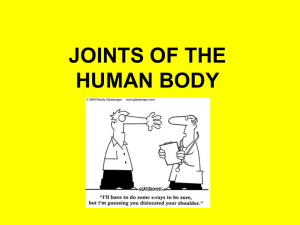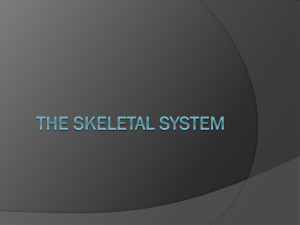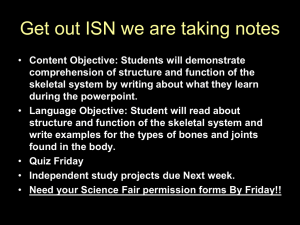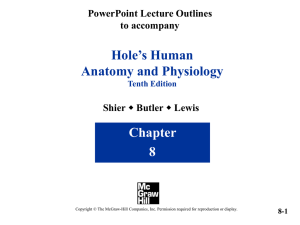Activity 4.1.1: Bones, Joints, Action! Introduction
advertisement
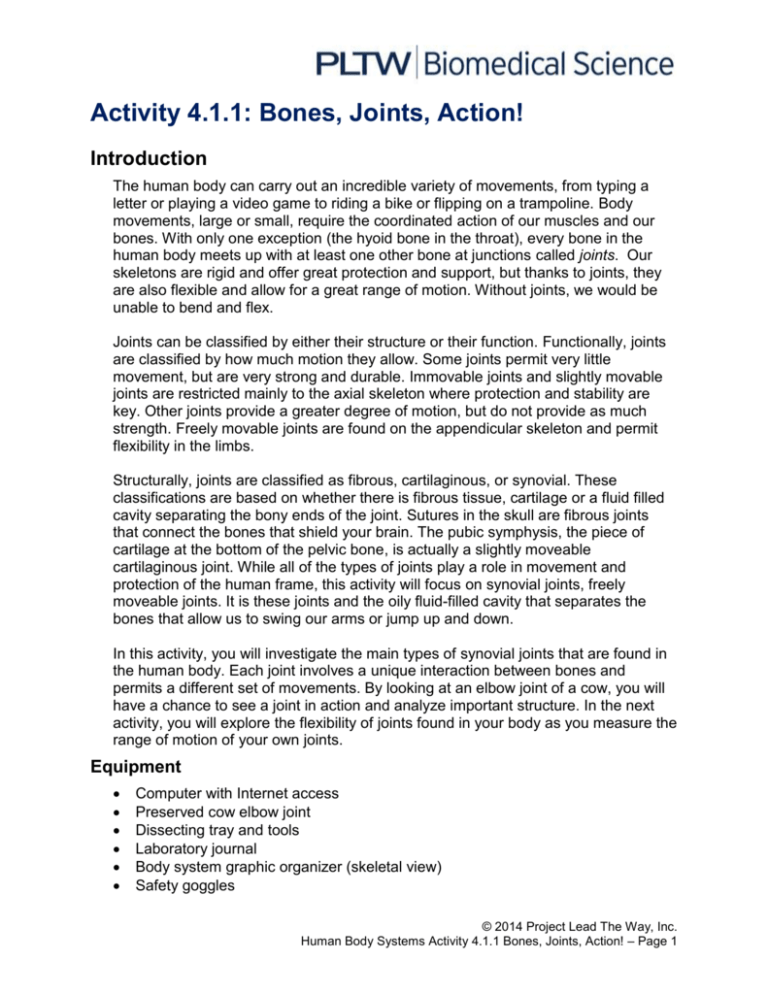
Activity 4.1.1: Bones, Joints, Action! Introduction The human body can carry out an incredible variety of movements, from typing a letter or playing a video game to riding a bike or flipping on a trampoline. Body movements, large or small, require the coordinated action of our muscles and our bones. With only one exception (the hyoid bone in the throat), every bone in the human body meets up with at least one other bone at junctions called joints. Our skeletons are rigid and offer great protection and support, but thanks to joints, they are also flexible and allow for a great range of motion. Without joints, we would be unable to bend and flex. Joints can be classified by either their structure or their function. Functionally, joints are classified by how much motion they allow. Some joints permit very little movement, but are very strong and durable. Immovable joints and slightly movable joints are restricted mainly to the axial skeleton where protection and stability are key. Other joints provide a greater degree of motion, but do not provide as much strength. Freely movable joints are found on the appendicular skeleton and permit flexibility in the limbs. Structurally, joints are classified as fibrous, cartilaginous, or synovial. These classifications are based on whether there is fibrous tissue, cartilage or a fluid filled cavity separating the bony ends of the joint. Sutures in the skull are fibrous joints that connect the bones that shield your brain. The pubic symphysis, the piece of cartilage at the bottom of the pelvic bone, is actually a slightly moveable cartilaginous joint. While all of the types of joints play a role in movement and protection of the human frame, this activity will focus on synovial joints, freely moveable joints. It is these joints and the oily fluid-filled cavity that separates the bones that allow us to swing our arms or jump up and down. In this activity, you will investigate the main types of synovial joints that are found in the human body. Each joint involves a unique interaction between bones and permits a different set of movements. By looking at an elbow joint of a cow, you will have a chance to see a joint in action and analyze important structure. In the next activity, you will explore the flexibility of joints found in your body as you measure the range of motion of your own joints. Equipment Computer with Internet access Preserved cow elbow joint Dissecting tray and tools Laboratory journal Body system graphic organizer (skeletal view) Safety goggles © 2014 Project Lead The Way, Inc. Human Body Systems Activity 4.1.1 Bones, Joints, Action! – Page 1 Gloves (optional) Reference textbook (optional) Procedure 1. Obtain a body system graphic organizer (skeletal view) from your teacher and place it aside. 2. Use the Internet or reference textbooks to research the structure and function of synovial joints, the main type of joints that assist with movement. Describe at least three distinguishing features of these joints in your laboratory journal. 3. Research the six main types of synovial joints. The animations described in Step 3 allow you to view each of the joints listed below in action. o o o o o o Pivot joint Ball-and-Socket joint Saddle joint Condyloid (Ellipsoidal) joint Hinge joint Plane (Planar or Gliding) joint 4. View the joint animations found at the BBC – Science and Nature: Human Body and Mind site, available at http://www.bbc.co.uk/science/humanbody/body/factfiles/joints/ball_and_so cket_joint.shtml. Use the controls on the screen to move each joint and explore how the bones move against one another. 5. For each type of joint, complete the following: o Describe the motion of the joint in your laboratory journal. o Draw a pencil sketch of how bones meet up at this joint. o Find an example of this type of joint in the body and label this example on a new body system graphic organizer (skeletal view) labeled “Joints.” Make sure to include the name of the joint as well as the type of joint. 6. Compare your findings with another student in the class. 7. Put on safety goggles. If instructed to do so by your teacher, put on gloves. 8. Form a team of four and obtain a cow elbow joint from your teacher. Place this joint in a dissecting tray or on a covered lab bench. 9. Obtain a diagram of the cow elbow from your teacher. 10. Use the diagram to help you orient your specimen so that the joint is in the position it would be in if the cow were standing. 11. Locate the humerus, ulna and radius. Observe that the humerus meets up with both the ulna and the radius, but the distal portion of the ulna fuses with the radius. The ulna and radius are visible, but do not appear as two distinct bones. How does this arrangement compare to the arm bones of a human? Refer to your Maniken® or your skeletal system graphic organizer if you need help visualizing the bones of the arm. © 2014 Project Lead The Way, Inc. Human Body Systems Activity 4.1.1 Bones, Joints, Action! – Page 2 12. Lift the humerus and watch the joint move. Do not be afraid to push on the joint so the humerus begins to point upward. 13. Extend the joint until you feel it lock into an extended position. This position allows a cow to stand for long periods of time while expending little energy. 14. Release the joint and feel how the joint moves back into its relaxed state. Allow each group member to feel this movement. 15. Extend the joint again so you can see the joint cavity, the space between the bones. If part of the joint capsule is still covering the opening to the joint, use your scissors to cut into the membrane and expose the interaction between the bones. 16. As a group, decide what type of synovial joint you are seeing in action. Compare your cow elbow to the pencil sketches in your laboratory journal. Be prepared to defend your decision. 17. Rub the surfaces of the condyles of the humerus with your fingers and note the texture of the articular (hyaline) cartilage. In a fresh specimen, this joint cavity would be filled with synovial fluid. In your laboratory journal, describe the function of this fluid. 18. Find the fat pads that cushion the joint. 19. Based on what you see in the diagram and on the cow elbow, describe the function of ligaments and tendons. Complete additional research if needed. 20. Find a remnant of a ligament on your cow joint. In your laboratory journal, describe the appearance of the ligament. 21. Note that hyaline cartilage, tendons and ligaments are all types of connective tissue. Describe the structure and function of each tissue in your laboratory journal. Refer back to the “Tissues” concept map you created in Activity 1.2.1. Add additional information about connective tissue to the concept map. 22. Turn the joint so you can view a cross-section of bone. In your laboratory journal, sketch what you see and describe the appearance of this bone in words. 23. Follow your teacher’s instructions to either save or dispose of the cow elbow. 24. Clean up your lab station. Conclusion 1. How do you think bones, muscles and joints work together to move the body? © 2014 Project Lead The Way, Inc. Human Body Systems Activity 4.1.1 Bones, Joints, Action! – Page 3 2. Your friend Andre comes to school and tells you that he has a dislocated shoulder. Based on what you now know about joints, what do you think this means? 3. How are tendons and ligaments similar and how are they different? 4. Explain why the elbow joint of a cow and the elbow joint of a human have similar, but not identical structure. Think about the actions each organism completes with this limb. 5. What type of joint is the hip joint? Describe the type(s) of movements this joint can perform. © 2014 Project Lead The Way, Inc. Human Body Systems Activity 4.1.1 Bones, Joints, Action! – Page 4



